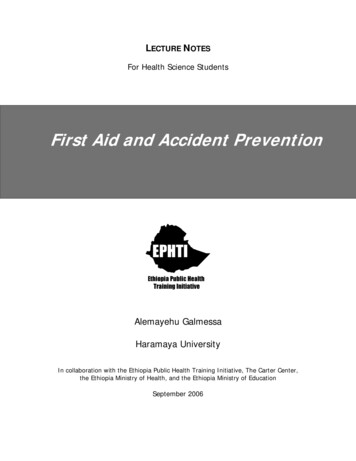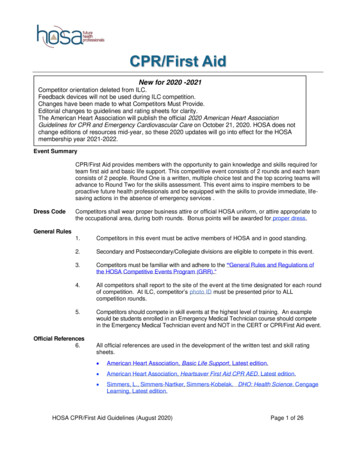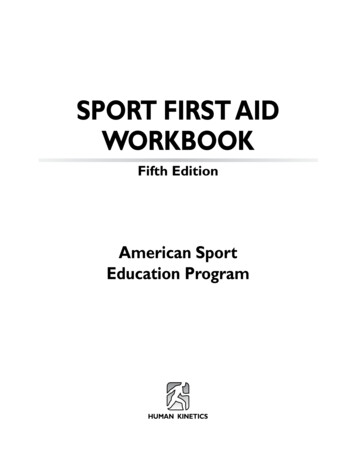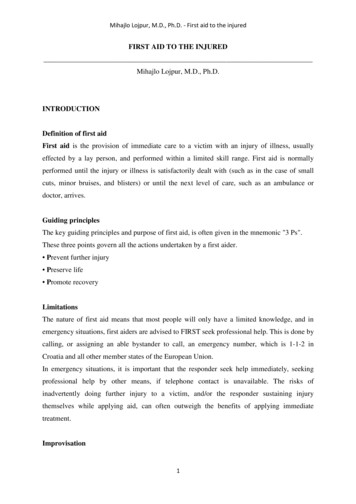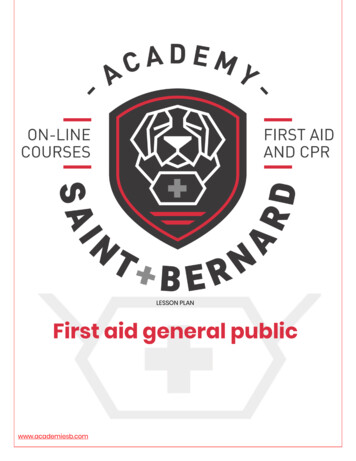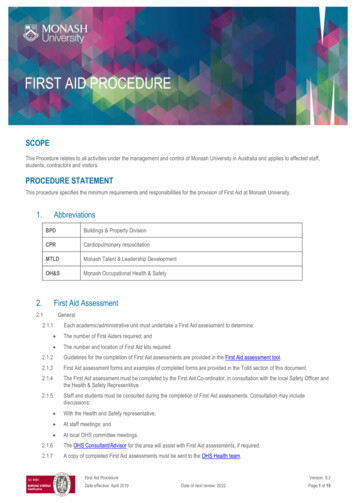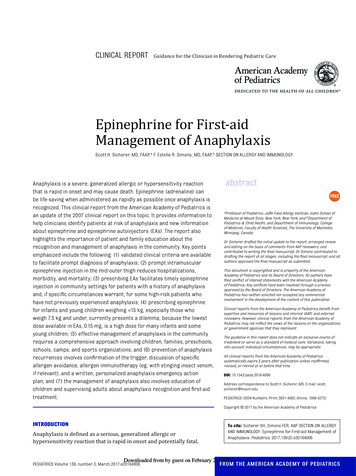
Transcription
CLINICAL REPORTGuidance for the Clinician in Rendering Pediatric CareEpinephrine for First-aidManagement of AnaphylaxisScott H. Sicherer, MD, FAAP,a F. Estelle R. Simons, MD, FAAP,b SECTION ON ALLERGY AND IMMUNOLOGYAnaphylaxis is a severe, generalized allergic or hypersensitivity reactionthat is rapid in onset and may cause death. Epinephrine (adrenaline) canbe life-saving when administered as rapidly as possible once anaphylaxis isrecognized. This clinical report from the American Academy of Pediatrics isan update of the 2007 clinical report on this topic. It provides information tohelp clinicians identify patients at risk of anaphylaxis and new informationabout epinephrine and epinephrine autoinjectors (EAs). The report alsohighlights the importance of patient and family education about therecognition and management of anaphylaxis in the community. Key pointsemphasized include the following: (1) validated clinical criteria are availableto facilitate prompt diagnosis of anaphylaxis; (2) prompt intramuscularepinephrine injection in the mid-outer thigh reduces hospitalizations,morbidity, and mortality; (3) prescribing EAs facilitates timely epinephrineinjection in community settings for patients with a history of anaphylaxisand, if specific circumstances warrant, for some high-risk patients whohave not previously experienced anaphylaxis; (4) prescribing epinephrinefor infants and young children weighing 15 kg, especially those whoweigh 7.5 kg and under, currently presents a dilemma, because the lowestdose available in EAs, 0.15 mg, is a high dose for many infants and someyoung children; (5) effective management of anaphylaxis in the communityrequires a comprehensive approach involving children, families, preschools,schools, camps, and sports organizations; and (6) prevention of anaphylaxisrecurrences involves confirmation of the trigger, discussion of specificallergen avoidance, allergen immunotherapy (eg, with stinging insect venom,if relevant), and a written, personalized anaphylaxis emergency actionplan; and (7) the management of anaphylaxis also involves education ofchildren and supervising adults about anaphylaxis recognition and first-aidtreatment.abstractaProfessorof Pediatrics, Jaffe Food Allergy Institute, Icahn School ofMedicine at Mount Sinai, New York, New York; and bDepartment ofPediatrics & Child Health, and Department of Immunology, Collegeof Medicine, Faculty of Health Sciences, The University of Manitoba,Winnipeg, CanadaDr Sicherer drafted the initial update to the report, arranged reviewand editing on the basis of comments from AAP reviewers, andcontributed to writing the final manuscript; Dr Simons contributed todrafting the report at all stages, including the final manuscript; and allauthors approved the final manuscript as submitted.This document is copyrighted and is property of the AmericanAcademy of Pediatrics and its Board of Directors. All authors havefiled conflict of interest statements with the American Academyof Pediatrics. Any conflicts have been resolved through a processapproved by the Board of Directors. The American Academy ofPediatrics has neither solicited nor accepted any commercialinvolvement in the development of the content of this publication.Clinical reports from the American Academy of Pediatrics benefit fromexpertise and resources of liaisons and internal (AAP) and externalreviewers. However, clinical reports from the American Academy ofPediatrics may not reflect the views of the liaisons or the organizationsor government agencies that they represent.The guidance in this report does not indicate an exclusive course oftreatment or serve as a standard of medical care. Variations, takinginto account individual circumstances, may be appropriate.All clinical reports from the American Academy of Pediatricsautomatically expire 5 years after publication unless reaffirmed,revised, or retired at or before that time.DOI: 10.1542/peds.2016-4006Address correspondence to Scott H. Sicherer, MD. E-mail: scott.sicherer@mssm.eduPEDIATRICS (ISSN Numbers: Print, 0031-4005; Online, 1098-4275).Copyright 2017 by the American Academy of PediatricsINTRODUCTIONAnaphylaxis is defined as a serious, generalized allergic orhypersensitivity reaction that is rapid in onset and potentially fatal.To cite: Sicherer SH, Simons FER, AAP SECTION ON ALLERGYAND IMMUNOLOGY. Epinephrine for First-aid Management ofAnaphylaxis. Pediatrics. 2017;139(3):e20164006Downloaded from by guest on February 24, 2017PEDIATRICS Volume 139, number 3, March 2017:e20164006FROM THE AMERICAN ACADEMY OF PEDIATRICS
Clinical presentation and severitycan vary among patients and in thesame patient from 1 anaphylacticepisode to another.1–3 Epinephrineis the primary initial treatment ofanaphylaxis.1–3 This clinical reportfrom the American Academy ofPediatrics (AAP) updates andamplifies the previous report on thistopic.4CLINICAL FEATURES OF ANAPHYLAXISClinical criteria for anaphylaxis havebeen proposed and validated.3,5Anaphylaxis is highly likely whenany 1 of the following 3 criteria isfulfilled:1. Acute onset of an illness(minutes to several hours), withinvolvement of the skin, mucosaltissue, or both (eg, generalizedurticaria, itching or flushing,swollen lips/tongue/uvula), andat least 1 of the following: (1)respiratory compromise (eg,dyspnea, wheeze/bronchospasm,stridor, hypoxemia) or (2)reduced blood pressure orassociated symptoms of endorgan dysfunction (eg, hypotonia[collapse], syncope, incontinence);OR2. Two or more of the following thatoccur suddenly after exposure toa likely allergen for that patient(minutes to several hours):(1) involvement of the skin/mucosal tissue (eg, generalizedurticaria, itch/flush, swollen lips/tongue/uvula), (2) respiratorycompromise (eg, dyspnea,wheeze/bronchospasm, stridor,hypoxemia), (3) reduced bloodpressure or associated symptoms(eg, hypotonia [collapse], syncope,incontinence), or (4) persistentgastrointestinal symptoms(eg, crampy abdominal pain,vomiting); OR3. Reduced blood pressure afterexposure to a known allergenfor that patient (minutes toe2several hours): (1) for infantsand children, low systolic bloodpressure (age-specific) or greaterthan 30% decrease in systolicblood pressure, and (2) forteenagers and adults, systolicblood pressure of less than 90mm Hg or greater than 30%decrease from that person’sbaseline.3These clinical criteria for thediagnosis of anaphylaxis have beenvalidated in emergency departmentstudies in children, teenagers, andadults. They have high sensitivity(96.7%), reasonable specificity(82.4%), and a high negativepredictive value (98%).3,5Disorders such as acute asthma,acute generalized urticaria,aspiration of a foreign body such asa peanut, vasovagal episode,and anxiety or panic attackscan present with some similarsymptoms.1 There are agerelated differences in the clinicalpresentation and differentialdiagnosis of anaphylaxis.6,7 Theclinical criteria have not yet beenvalidated in infants.Foods, especially peanut, treenuts, milk, eggs, crustaceanshellfish, and finned fish, are byfar the most common triggersof anaphylaxis in the pediatricpopulation.8,9 Insect stings, drugssuch as antibiotics, and variousother allergens can also triggeranaphylaxis1,2,10,11; however,vaccinations to prevent infectiousdiseases seldom trigger it.12Cofactors that lower the thresholdat which triggers can causeanaphylaxis include exercise,upper respiratory tract infections,fever, ingestion of nonsteroidalantiinflammatory drugs or ethanol,emotional stress, and perimenstrualstatus.13–15 Fatal anaphylaxis isoften associated with adolescence,concomitant asthma (especiallyif severe or poorly controlled),and failure to inject epinephrinepromptly.16–18Downloaded from by guest on February 24, 2017PRIMARY ROLE OF EPINEPHRINEEpinephrine is the medication ofchoice for the first-aid treatment ofanaphylaxis. Through vasoconstrictoreffects, it prevents or decreasesupper airway mucosal edema(laryngeal edema), hypotension, andshock. In addition, it has importantbronchodilator effects and cardiacinotropic and chronotropiceffects.1–4,19–24Delayed epinephrine administrationin anaphylaxis is associated with anincreased risk of hospitalization22and poor outcomes, includinghypoxic-ischemic encephalopathyand death.16–18 Conversely, promptprehospital epinephrine injectionis associated with a lower risk ofhospitalization22 and fatality.1,2,16–18H1-antihistamines prevent andrelieve itching and hives butdo not relieve life-threateningrespiratory symptoms, hypotension,or shock1,2,4,8,25,26; therefore,like H2-antihistamines andglucocorticoids, they are adjunctivetreatments and are not appropriatefor use as the initial treatment orthe only treatment.1,2,8,25,27,28 Forchildren with concomitant asthma,inhaled β2-adrenergic agonists (eg,albuterol) can provide additionalrelief of lower respiratory tractsymptoms but, like antihistaminesand glucocorticoids, are notappropriate for use as the initial oronly treatment in anaphylaxis.1,2,8EPINEPHRINE ADMINISTRATION ANDDOSINGEpinephrine can be life-savingwhen injected promptly by theintramuscular (IM) route in the midouter thigh (vastus lateralis muscle)as soon as anaphylaxis is recognized(Table 1).1,2,4,6,8–10,23,24 For firstaid management of anaphylaxis inhealth care settings, traditionallyan epinephrine dose of 0.01 mg/kgis injected IM, to a maximum of 0.3mg in a prepubertal child and up to0.5 mg in a teenager. EpinephrineFROM THE AMERICAN ACADEMY OF PEDIATRICS
TABLE 1 Anaphylaxis: Recognition and First-aid TreatmentHow to recognize anaphylaxisaAnaphylaxis has a sudden onset (minutes to a few hours) after exposure to a food, drug, insect sting, or other trigger. It potentially involves some of thefollowing symptoms and signs: skin: itching, redness, hives, or swelling; oral and nasal mucosa: itching, swelling; conjunctivae: itching, swelling, redness; respiratory tract: hoarseness, throat itching, throat tightness, stridor, cough, difficulty breathing, chest tightness, wheeze, cyanosis; cardiovascular symptoms: tachycardia, chest pain, hypotension, weak pulse, dizziness, collapse, incontinence, shock; gastrointestinal tract symptoms: nausea, crampy abdominal pain, persistent vomiting, diarrhea; and central nervous system: behavioral changes (infants), sense of doom, headache, altered mental status, confusion, tunnel vision.How to treat anaphylaxisBe prepared! Have a written anaphylaxis emergency action plan.When anaphylaxis occurs, promptly assess the patient’s airway, breathing, circulation, and skin and call for help: 911 or EMS in community settings, aresuscitation team in health care settings.Inject epinephrine (adrenaline) IM in the mid-outer aspect of the thigh by using an EA. If needed, give a second injection 5 to 15 minutes after the first.Place the patient on his or her back or in a position of comfort if there is respiratory distress and/or vomiting. Elevate the lower extremities. Do not allowstanding, walking, or running.Transport the patient to an emergency department, preferably by an EMS vehicle, for further assessment and monitoring. Additional treatment, includingsupplemental oxygen, intravenous fluids, and other interventions may be needed.Adapted from refs 1–3,6.can differ among patients, and even in the same patient from 1 episode to the next. Typically,more than 1 body organ system is involved.a Note that only a few anaphylaxis symptoms may be present during an episode. Also, symptomsautoinjectors (EAs) can be used inhealth care settings to deliver a0.15-mg dose in a young child and a0.3-mg dose in a child or teenager.If the response to the firstepinephrine injection is inadequate,it can be repeated once or twice at5- to 15-minute intervals.1,2,8 From6% to 19% of pediatric patientstreated with a first epinephrineinjection in anaphylaxis require asecond dose.29–31 A third dose isneeded infrequently. Subsequentdoses are typically given by ahealth care professional alongwith other interventions.1,2,4,8 In aretrospective chart review study inemergency department patients withanaphylaxis, most of whom werechildren, 17% of those who received1 epinephrine injection required 1or more additional doses. The needfor subsequent injections did notcorrelate with obesity or overweightstatus.31Subsequent epinephrine dosesare needed for severe or rapidlyprogressive anaphylaxis and forfailure to respond to the initialinjection because of delayed injectionof the initial dose, inadequate initialdose, or administration througha suboptimal route.23 Subsequentdoses also might be needed inPEDIATRICS Volume 139, number 3, March 2017biphasic anaphylaxis, defined asrecurrence of symptoms hoursafter resolution of initial symptomsdespite no further exposure to thetrigger, which is reported in up to11% of pediatric patients. Foodinduced anaphylaxis is associatedwith biphasic anaphylaxis less oftenthan is venom- or drug-inducedanaphylaxis.32,33Reluctance to inject epinephrinepromptly at the onset of anaphylaxissymptoms is best overcome byawareness that the severity of ananaphylactic episode can differ from1 patient to another and in the samepatient from 1 episode to another.21At the onset, it is impossible topredict whether the patient willrespond promptly to treatment,die within minutes, or recoverspontaneously because of secretionof endogenous epinephrine.SAFETY OF EPINEPHRINEPharmacologic effects of epinephrineinclude transient pallor, tremor,anxiety, and palpitations, which,although perceived as adverseeffects, are similar to the symptomscaused by increased endogenousepinephrine levels produced in the“fight or flight” response. TheseDownloaded from by guest on February 24, 2017effects cannot be dissociated from thebeneficial effects of epinephrine.23Epinephrine given by IM injectionachieves peak concentrations fasterthan that given by subcutaneousinjection.20 Epinephrine, 0.3 mg IM,is 10 times safer than epinephrinegiven as an intravenous bolus.34Serious adverse effects of IMepinephrine are rare in children.There is no absolute contraindicationto epinephrine treatment inanaphylaxis.1,2,8,23DILEMMAS IN EPINEPHRINE DOSINGOnly 2 premeasured, fixed dosesof epinephrine, 0.15 mg and 0.3 mg,are currently available in EAformulations in the United States andCanada.35 EA manufacturers adviseprescribing the 0.15-mg dose forpatients weighing 15 to 30 kg and the0.3-mg dose for those weighing 30 kgand over. These doses are optimal formany children but not necessarily forall children.The 0.15-mg dose is high for infants(a twofold dose for those weighing 7.5 kg) and for some youngchildren.6,21 Some EA manufacturershave suggested that an alternativeapproach for infants is to havecaregivers draw up the dose frome3
a 1-mL ampule by using a 1-mLsyringe. However, dose preparationcan take laypersons as long as 3 to 4minutes; moreover, doses typicallyare inaccurate and can sometimescontain no epinephrine at all whenthe solution is ejected from thesyringe along with the air.36 Althoughunsealed 1-mL syringes prefilledby a health care professional withinfant epinephrine doses also havebeen recommended, the doses canbe lost, and the epinephrine solutiontypically degrades within a fewmonths as a result of air exposure.37After consideration of theaforementioned alternatives thatpotentially lead to delay in dosing,incorrect dosing, or no dose at alland consideration of the favorablebenefit-to-risk ratio of epinephrinein young patients with anaphylaxis,many physicians recommend theuse of the 0.15-mg EA in infants.6Most pediatricians (80%) report thatthey would prescribe the 0.15-mgEA for an infant or a child weighing10 kg (22 lb).38 Internationalguidelines suggest that, when usingEAs, patients weighing 7.5 to 25 kgshould receive the 0.15-mg dose.39Physicians can discuss the benefitsand risks of these options withfamilies and prescribe on a case-bycase basis.21On the basis of a pharmacokineticstudy40 and expert consensus, it isappropriate to switch most childrenfrom the 0.15-mg dose to the 0.3-mgdose when they reach a body weightof 25 to 30 kg (55–66 lb).4,8,35PRESCRIBING EASMost anaphylaxis deaths occur incommunity settings rather than inhealth care settings1,16–18; yet, somephysicians fail to prescribe EAs fortheir patients at risk of anaphylaxisin the community.41 These patientsinclude those with a history ofanaphylaxis who can re-encountertheir triggers, such as foods orstinging insects, those with idiopathice4anaphylaxis, and those at increasedrisk of anaphylaxis who might notyet have experienced it (see nextparagraph),1,2,8–10 including patientsliving in remote areas with minimalor no access to emergency medicalservices (EMS).1,2,4,35,39EA use; detailed information abouthow to avoid specific allergens; andallergen immunotherapy (eg, venomimmunotherapy, if relevant) toprevent the recurrence of insect stinganaphylaxis.1,2,10,43,44EA prescriptions also can beconsidered for patients with knownsensitization to peanut, tree nuts,cow’s milk, crustacean shellfish, andfish, which potentially are associatedwith severe and fatal anaphylaxis andcan be difficult to avoid (eg, whenpeanut or milk are hidden ingredientsin manufactured foods).8,9Consideration of prescribing an EAis especially important if the patienthas had a previous food-inducedallergic reaction, such as generalizedacute urticaria, has reacted to traceamounts of a food, or has food allergyand concomitant asthma, whichincreases the risk of fatality fromanaphylaxis. In fact, some expertshave suggested that considerationbe given to prescribing EAs for allpatients with immunoglobulin E–mediated food allergy, because itis difficult or impossible to predictthe occurrence or severity of futurereactions.8,9 It can be beneficial toprescribe EAs for children with ahistory of acute generalized urticariaafter an insect sting, because ifre-stung, the risk of a more severesystemic reaction is approximately5% in this population.10,35USING EASDefinitive evaluation by an allergy/immunology specialist can provideconfirmation of the diagnosisof anaphylaxis and the triggerand, for patients with idiopathicanaphylaxis, can clarify thediagnosis by performing additionalinvestigations that reveal a triggeror identify comorbidities, such assystemic mastocytosis.1,2,42 Allergy/immunology specialists also initiatecomprehensive preventive care:prescription of EAs in the context ofwritten, personalized anaphylaxisemergency action plans; educationabout anaphylaxis recognition andDownloaded from by guest on February 24, 2017Guidelines recommend promptepinephrine injection for the suddenonset of any anaphylaxis symptomsafter exposure to an allergen thatpreviously caused anaphylaxis inthat patient.1,2,8–10 Systemic allergicreactions can rapidly progress frommild to life-threatening symptoms,and early treatment before, or atthe first sign of, symptoms cansometimes prevent escalationof symptoms.35 As an example,generalized acute urticaria is notlife-threatening; yet, in a communitysetting, in the context of a knownexposure to an allergen (eg, peanutor milk) that previously triggeredanaphylaxis, it could be beneficialto inject epinephrine to preventadditional symptoms.8,35 It cansometimes be difficult to distinguishanaphylaxis from other diagnosticentities such as acute asthma, acutegeneralized urticaria, aspiration ofa foreign body such as a peanut, avasovagal episode, or an anxiety orpanic attack.35 In such situations, ifunsure, erring on the side of cautionand injecting epinephrine, thenobserving the patient closely, isadvised.Even physicians with years ofexperience in diagnosing andtreating anaphylaxis cannotdetermine, at the onset of an episode,whether that episode will remainmild or escalate over minutes tobecome life-threatening. In thissituation, although some oralH1-antihistamines relieve itching andhives within 30 or 40 minutes,25,26severe, life-threatening respiratoryand/or cardiovascular symptomscan appear suddenly after the hiveshave disappeared.1,8,24 In communityFROM THE AMERICAN ACADEMY OF PEDIATRICS
settings, patients experiencinganaphylaxis or caregivers withoutmedical training may be so anxiousthat they cannot assess the situationaccurately and remember what todo. It is therefore important thatphysicians instruct patients andcaregivers to err on the side ofprompt epinephrine injection.1,3,8,35Many patients and caregiversfail to carry EAs consistently orto use them when anaphylaxisoccurs, even for severe symptoms,including throat tightness, difficultybreathing, wheezing, and loss ofconsciousness.41,45,46 People mayhave different reasons for notusing EAs, including failure torecognize anaphylaxis symptoms,spontaneous recovery from aprevious anaphylactic episodeand the assumption that this willhappen in every episode, relianceon oral H1-antihistamines and/or inhaled bronchodilators, noEA available, fear of needles,and concerns about epinephrineadverse effects.41,45–48Many parents fear using an EAbecause they worry about hurtingor injuring their child or a badoutcome.46,47 Unintentional injectionsinto digits and other body parts, withor without injuries,48 and lacerationsincurred when an inadequatelyrestrained child moves during theinjection are reported from pen-typeEAs.49Teenagers are at increased risk ofdeath in anaphylaxis16–18 becauseof high-risk behaviors, includingethanol and/or recreational drug use,failure to recognize triggers, denialof symptoms, and failure to carrytheir EAs and inject epinephrinepromptly when anaphylaxisoccurs.16–18 Additional efforts toprovide anaphylaxis education foradolescents, their peers, and theircommunities are needed.50Patients and caregivers needtraining in how to recognizeanaphylaxis and use an EA.PEDIATRICS Volume 139, number 3, March 2017Epinephrine injections can be giventhrough clothing, although caremust be taken to avoid obstructingseams or items in pockets. Regularreview (eg, annually) of anaphylaxisrecognition and injection techniqueis advisable, because errors arecommon and acquired skills maynot be retained permanently.51,52Technique can be practiced at homeby using a “trainer.” Various EAsmay come to market having differentmechanisms of activation andvariations in ease of use.53,54Education about anaphylaxisrecognition and injection techniqueis advised to ensure familiarity withthe specific device prescribed.After treatment with epinephrinefor anaphylaxis in communitysettings, it is important for patientsto be assessed in an emergencydepartment to determine whetheradditional interventions areneeded.1,2,8 It may be helpful forfamilies to know they are seekingadditional medical care not becauseof the use of the EA, a safe treatment,but rather to assess and monitor theanaphylactic episode.Pediatric allergists who aremembers of the AAP Section onAllergy and Immunology weresurveyed about when they typicallybegin to transfer responsibilitiesfor anaphylaxis recognition andEA use from adult caregivers tochildren and teenagers at risk ofanaphylaxis in community settings.They expected that by age 12 to14 years, their patients should beginto share these responsibilities.They started to train early andindividualized the time of transferon the basis of patient factors,such as the presence of asthma andabsence of cognitive dysfunction.55In contrast, caregivers of at-riskchildren and teenagers who weresurveyed expected to begin transferof responsibilities considerablyearlier, by 6 to 11 years of age.56In both of these studies, theinvestigators commented thatDownloaded from by guest on February 24, 2017adults (parents, teachers, coaches,and others) have the ultimateresponsibility for children andteenagers under their supervisionwho experience anaphylaxis.55,56It is advised not to store EAsunder conditions of excessiveheat or cold (eg, in a car or beachbag on a hot day). Manufacturersrecommend keeping them at20 to 25 C (68 –77 F), withexcursions permitted to 15 to30 C (59 –86 F). Degradation ofthe epinephrine solution in EAs canoccur without visible discolorationor precipitates. It is beneficial tocheck EA expiration dates andrenew prescriptions in a timelymanner. However, if the only EAavailable during an episode ofanaphylaxis is past the expirationdate, it can be used in preference tono epinephrine injection atall.57–59ANAPHYLAXIS EMERGENCY ACTIONPLANS AND MEDICAL IDENTIFICATIONEAs are best prescribed in thecontext of written, personalizedanaphylaxis emergency action plans.Such plans typically list commonsymptoms and signs of anaphylaxisand outline initial anaphylaxistreatment (Table 1): specifically,prioritize calling for help (911 orEMS), injecting epinephrine from anEA, and positioning the patient supineor in a position of comfort.1–3,6,8 Actionplans can also provide informationsuch as the individual’s anaphylaxistriggers and, if relevant, any historyof severe anaphylaxis and/orcomorbid conditions such as asthma.In addition, they can remind readersthat H1-antihistamines and asthmainhalers should not be used as theinitial treatment or only treatment ofanaphylaxis.Patients at risk of anaphylaxisrecurrences can wear medicalidentification jewelry and/orcarry a wallet card that states“anaphylaxis” and lists theire5
confirmed triggers and relevantcomorbidities such as asthma.Knowledge about the recognitionand treatment of anaphylaxisincreased significantly after briefstudy of an anaphylaxis walletcard.60 Plans and medical IDsare best reviewed and updatedregularly, such as annually.1,2,8SPECIAL ISSUES FOR SCHOOLS ANDOTHER PUBLIC VENUESPrevention and treatment ofanaphylaxis in schools, child caresettings, camps, and other venuesfor young people are multifacetedand require a comprehensiveapproach, including awarenesstraining and practical preparation.61Approaches are outlined in an AAPclinical report61 and in guidelinesfrom the Centers for Disease Controland Prevention (http://www.cdc.gov/healthyyouth/foodallergies).In many US schools, unassignedEAs are available for use whenanaphylaxis occurs in a studentwho does not have a personal EAavailable62; clinicians can check withtheir state legislature regarding suchregulations.SUMMARY1. Epinephrine is the medicationof choice for the initialtreatment of anaphylaxis. Ifinjected promptly, it is nearlyalways effective. Delayedinjection can be associatedwith poor outcomes, includingfatality. All other medications,including H1-antihistamines andbronchodilators such as albuterol,provide adjunctive treatmentbut do not replace epinephrine.After treatment with epinephrinefor anaphylaxis in communitysettings, it is important forpatients to be assessed in anemergency department todetermine whether additionalinterventions, including oxygen,e6intravenous fluids, and adjunctivemedications, are needed.2. When anaphylaxis occurs inhealth care settings, epinephrine(0.01 mg/kg [maximum dose:0.3 mg in a prepubertal childand up to 0.5 mg in a teenager])by IM injection in the mid-outerthigh (vastus lateralis muscle) isrecommended. IM epinephrineachieves peak epinephrineconcentrations promptly and issafer than an intravenous bolusinjection.3. When anaphylaxis occurs incommunity settings, EAs arepreferred because of their easeof use and accuracy of dosingas compared with the use ofan ampule, syringe, and needleby laypersons or the use of anunsealed syringe prefilled withepinephrine. In the United Statesand Canada, EAs are currentlyavailable in only 2 fixed doses:0.15 mg and 0.3 mg. Internationalguidelines suggest that whenusing EAs, patients weighing7.5 kg (16.5 lb) to 25 kg (55 lb)should receive the 0.15-mg dose;although this dose is not idealfor those who weigh less than 15kg (33 lb), the alternatives areassociated with delay in dosing,inaccurate dosing, and potentialloss of the dose. It is reasonableto recommend EAs containinga 0.3-mg epinephrine dose forthose weighing 25 kg (55 lb) ormore.4. It is beneficial to prescribeEAs for all patients who haveexperienced anaphylaxis and whomay re-encounter their trigger ina community setting. If specificcircumstances warrant, EAs mayalso be prescribed for some highrisk patients without a history ofanaphylaxis.5. Epinephrine is best prescribedin the context of a written,personalized anaphylaxisemergency action plan,Downloaded from by guest on February 24, 2017developed by the medical homewith input from the family.A relevant AAP clinical reportprovides an example of such awritten plan with instructionson completing it.63 Protocolsfor the use of unassigned EAsmay also be beneficial. Childrenat risk of anaphylaxis requirea comprehensive approach tomanagement. It is important toteach patients and caregivershow to recognize anaphylaxissymptoms; when, why, and howto use an EA; and the rationale forcalling 911 or EMS.6. Children who have experiencedanaphylaxis benefit fromevaluation by an allergy/immunology specialist forconfirmation of the diagnosis,confirmation of specific triggers,and preventive care.LEAD AUTHORSScott H. Sicherer, MD, FAAPF. Estelle R. Simons, MD, FAAPSECTION ON ALLERGY AND IMMUNOLOGYEXECUTIVE COMMITTEE, 2014–2015Todd A. Mahr, MD, FAAP, ChairStuart L. Abramson, MD, PhD, FAAPChitra Dinakar, MD, FAAPThomas A. Fleisher, MD, FAAPAnne-Marie Irani, MD, FAAPJennifer S. Kim, MD, FAAPElizabeth C. Matsui, MD, FAAPScott H. Sicherer, MD, FAAP, Immediate Past ChairLIAISON TO THE SECTION ON ALLERGY ANDIMMUNOLOGYPaul V. Williams, MD, FAAP – American Academy ofAllergy, Asthma, and ImmunologySTAFFDebra L. Burrowes, MHAABBREVIATIONSAAP: American Academy ofPediatricsEA: epinephrine autoinjectorEMS: emergency medicalservicesIM: intramuscular(ly)FROM THE AMERICAN ACADEMY OF PEDIATRICS
FINANCIAL DISCLOSURE: The authors have indicated they do not have a financial relationship relevant to this article to disclose.FUNDING: No external funding.POTENTIAL CONFLICT OF INTEREST: The authors have indicated they have no potential conflicts of interest to disclose.REFERENCES1. Simons FER, Ardusso LRF, Bilo MB, et al.World Allergy Organization guidelinesfor the assessment and managementof anaphylaxi
PEDIATRICS Volume 139 , number 3 , March 2017 :e 20164006 FROM THE AMERICAN ACADEMY OF PEDIATRICS Epinephrine for First-aid Management of Anaphylaxis Scott H. Sicherer, MD, FAAP, a F. Estelle R. Simons, MD, FAAP, b SECTION ON ALLERGY AND IMMUNOLOGY aProfessor of Pediatrics

